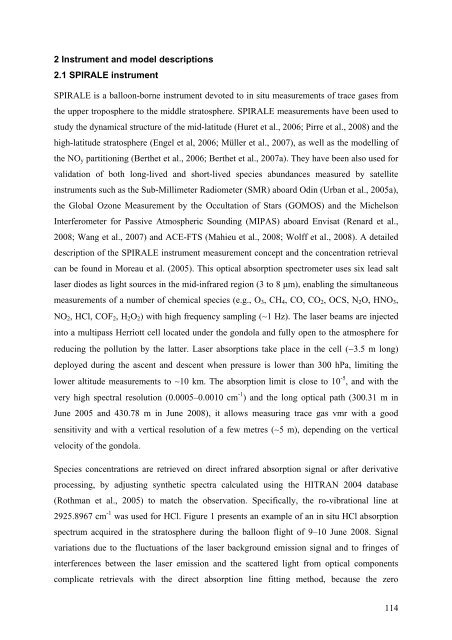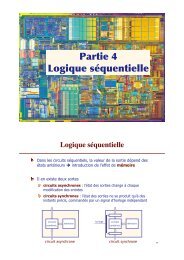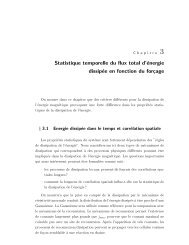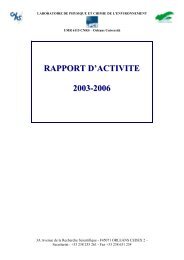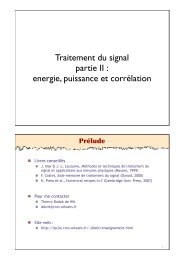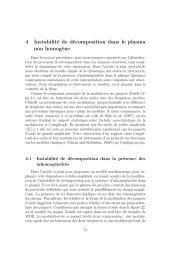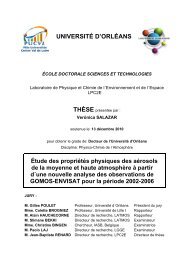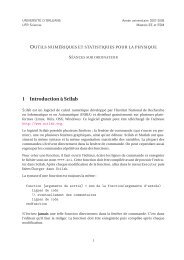UNIVERSITÉ D'ORLÉANS - Laboratoire de physique et chimie de l ...
UNIVERSITÉ D'ORLÉANS - Laboratoire de physique et chimie de l ...
UNIVERSITÉ D'ORLÉANS - Laboratoire de physique et chimie de l ...
Create successful ePaper yourself
Turn your PDF publications into a flip-book with our unique Google optimized e-Paper software.
2 Instrument and mo<strong>de</strong>l <strong>de</strong>scriptions<br />
2.1 SPIRALE instrument<br />
SPIRALE is a balloon-borne instrument <strong>de</strong>voted to in situ measurements of trace gases from<br />
the upper troposphere to the middle stratosphere. SPIRALE measurements have been used to<br />
study the dynamical structure of the mid-latitu<strong>de</strong> (Hur<strong>et</strong> <strong>et</strong> al., 2006; Pirre <strong>et</strong> al., 2008) and the<br />
high-latitu<strong>de</strong> stratosphere (Engel <strong>et</strong> al, 2006; Müller <strong>et</strong> al., 2007), as well as the mo<strong>de</strong>lling of<br />
the NOy partitioning (Berth<strong>et</strong> <strong>et</strong> al., 2006; Berth<strong>et</strong> <strong>et</strong> al., 2007a). They have been also used for<br />
validation of both long-lived and short-lived species abundances measured by satellite<br />
instruments such as the Sub-Millim<strong>et</strong>er Radiom<strong>et</strong>er (SMR) aboard Odin (Urban <strong>et</strong> al., 2005a),<br />
the Global Ozone Measurement by the Occultation of Stars (GOMOS) and the Michelson<br />
Interferom<strong>et</strong>er for Passive Atmospheric Sounding (MIPAS) aboard Envisat (Renard <strong>et</strong> al.,<br />
2008; Wang <strong>et</strong> al., 2007) and ACE-FTS (Mahieu <strong>et</strong> al., 2008; Wolff <strong>et</strong> al., 2008). A <strong>de</strong>tailed<br />
<strong>de</strong>scription of the SPIRALE instrument measurement concept and the concentration r<strong>et</strong>rieval<br />
can be found in Moreau <strong>et</strong> al. (2005). This optical absorption spectrom<strong>et</strong>er uses six lead salt<br />
laser dio<strong>de</strong>s as light sources in the mid-infrared region (3 to 8 µm), enabling the simultaneous<br />
measurements of a number of chemical species (e.g., O3, CH4, CO, CO2, OCS, N2O, HNO3,<br />
NO2, HCl, COF2, H2O2) with high frequency sampling (∼1 Hz). The laser beams are injected<br />
into a multipass Herriott cell located un<strong>de</strong>r the gondola and fully open to the atmosphere for<br />
reducing the pollution by the latter. Laser absorptions take place in the cell (∼3.5 m long)<br />
<strong>de</strong>ployed during the ascent and <strong>de</strong>scent when pressure is lower than 300 hPa, limiting the<br />
lower altitu<strong>de</strong> measurements to ∼10 km. The absorption limit is close to 10 -5 , and with the<br />
very high spectral resolution (0.0005–0.0010 cm -1 ) and the long optical path (300.31 m in<br />
June 2005 and 430.78 m in June 2008), it allows measuring trace gas vmr with a good<br />
sensitivity and with a vertical resolution of a few m<strong>et</strong>res (∼5 m), <strong>de</strong>pending on the vertical<br />
velocity of the gondola.<br />
Species concentrations are r<strong>et</strong>rieved on direct infrared absorption signal or after <strong>de</strong>rivative<br />
processing, by adjusting synth<strong>et</strong>ic spectra calculated using the HITRAN 2004 database<br />
(Rothman <strong>et</strong> al., 2005) to match the observation. Specifically, the ro-vibrational line at<br />
2925.8967 cm -1 was used for HCl. Figure 1 presents an example of an in situ HCl absorption<br />
spectrum acquired in the stratosphere during the balloon flight of 9–10 June 2008. Signal<br />
variations due to the fluctuations of the laser background emission signal and to fringes of<br />
interferences b<strong>et</strong>ween the laser emission and the scattered light from optical components<br />
complicate r<strong>et</strong>rievals with the direct absorption line fitting m<strong>et</strong>hod, because the zero<br />
114


